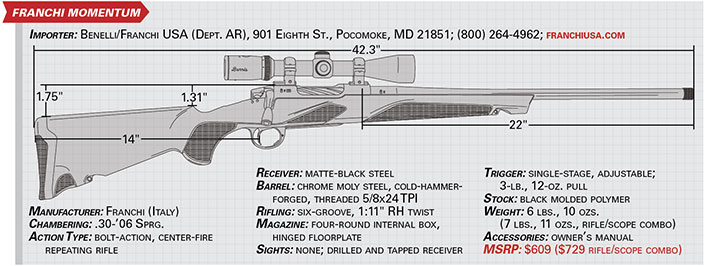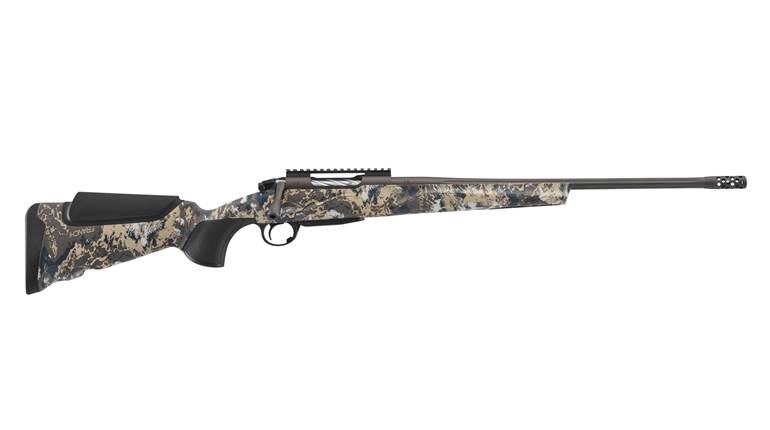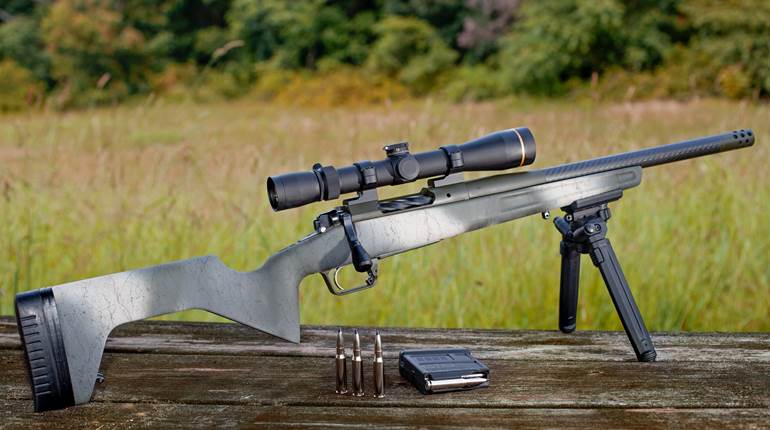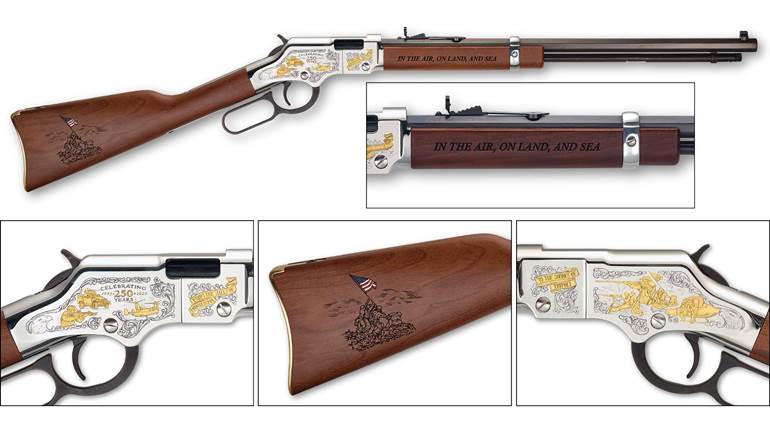
The moment had nearly arrived. The air was cool, high in the Canadian Rockies, and the horses were tired, as was I after a long day of scouting and stalking.
But I was well-placed, now, hidden among the thick mountain willows, with an oft-tread game trail to my front, and confirmation from a pair of cow elk that I was one with my surroundings—passing immediately in front of me, the animals neither saw me in the shadows, nor smelled me through the scent of horse acquired by hours in the saddle. Within moments, I hoped, tall antlers briefly spotted through the trees would emerge, this time along with the great head and body of a bull elk, which, to this point, had been concealed.
My friend and fellow hunter—shooting editor for Outdoor Life—John Snow and I, along with our guide, were experiencing a truly memorable first day of hunting. We were in Alberta’s Ya Ha Tinda, a federally operated horse ranch and recreation area sited on the northern bank of the Red Deer River and the eastern edge of Banff National Park. We’d traveled to Canada to take part in the first North American field test of Franchi’s new Momentum bolt-action rifle. The Ya Ha Tinda’s bear- and game-rich mountains feature stark stone cliff faces, large swathes of dense timber, ample creeks and plunging waterfalls. Its big country and expansive views make the ranch a favorite destination for local trail riders, and a truly exceptional hunting ground for the very few sportsmen permitted afield each year. Hunting out of a rustic riverside camp, we’d driven our horses deep into the wilderness. With light fading, and having seen sign of grizzly, elk and deer, we’d made our turn for home when the shrill, yet bellowing, call of the bull elk arrested our descent and encouraged one more hunt before the rapidly retreating sun diminished behind western peaks.

Franchi, today, is best known for its fine, yet affordable, Italian-made, over-under and semi-automatic shotguns. Originally founded in Brescia, Italy, the company has been in the firearm business since at least 1868, and has had a presence in the United States market for nearly 100 years. In the late 1990s, Benelli USA took over importation and distribution of the Franchi line, increasing its public profile, and, more recently, under the Benelli umbrella, Franchi USA was established to better engage the American consumer. The company has garnered praise in recent years for its Instinct line of over-under shotguns, the Affinity family of intertia-driven semi-automatics and Catalyst models of the aforementioned platforms—shotguns tastefully designed to better fit the anatomy of female shooters.
I was surprised then, when I was asked to field test a Franchi bolt-action, center-fire rifle—the company’s first such offering. Once I received the rifle and specifications, though, the Momentum’s lineage was clear, as was its appeal for American sportsmen and women. The rifle has class and styling, including some lines you would be unsurprised to find on a European long gun. But the design also shows restraint and emphasizes utility, which demonstrates an understanding of American sensibilities. There are embellishments, sure, but they have purpose, and for all its grace, the Momentum is priced to sell.
Though built in Franchi’s Urbino facility, near Italy’s eastern coast, the cold-hammer-forged barrel at the heart of the Momentum rifle is produced in northern Italy by Sabatti, in Gardone, to Franchi’s specifications. Initially, the rifle is available in six chamberings, and the barrel length and rifling twist rate is determined by the cartridge: .243 Win., 22", 1:10" RH; 6.5 mm Creedmoor, 24", 1:8" RH; .270 Win., 22", 1:10" RH; .308 Win., 22", 1:11" RH; .30-’06 Sprg., 22", 1:11" RH; and .300 Win. Mag., 24", 1:11" RH. In its primary configuration, the Momentum’s free-float barrel is threaded, 5/8x24 TPI, and capped by a knurled thread protector. Rifles chambered for .243 Win., .270 Win. and .308 are also available with un-threaded barrels, and all chamberings are offered in a combo package that includes threaded barrels and a Burris Fullfield II 3-9X 40 mm riflescope mounted with Burris Zee rings.

Both rifles I’ve tested, an early rendition for the elk hunt and a production model for formal review, have been chambered for .30-’06 Sprg. with 22" threaded barrels. For me, the rifle’s most striking feature has to be its stock. It’s a molded polymer design, yes, but not like those I’ve seen previously. The stock’s lines, contours, texturing and semi-glossy sheen really make the Momentum stand out from the crowd. And, as I mentioned earlier, the stock wasn’t designed simply for aesthetic appeal, though it has that in spades; it was designed for functionality. Scaled texturing can be found not only on the grip and fore-end, but also just below the receiver and at the toe of the buttstock—everywhere one might benefit from added purchase when shooting from field positions or at the bench, or when carrying the rifle on a stalk.
The Momentum’s ergonomic qualities are reinforced by the stock’s curves and contours, which swell and diminish to create finger rests and handholds in strategic locations. Franchi’s tagline, “Feels Right,” may have been authored in reference to the company’s smoothbore offerings, but it certainly applies to its first bolt-action rifle. The stock is capped by the company’s TSA recoil pad, which does a good job of soaking up a firearm’s kick, whether a 12-ga. scattergun or a .30-cal. rifle. The only feature I’m so-so on is the sling attachment studs. Integral to the stock, Franchi opted to mold the two studs into fin-shaped recesses, fore and aft. I love the way they look, but it’s not convenient for bipod attachment. The engineers did, however, reinforce a small section of the fore-end—an easily identifiable semi-circular area, just behind the sling stud—to accommodate the installation of a third stud or a QD-style adaptor.
The receiver is mated to the Momentum’s stock by two action screws that traverse the gun’s polymer trigger guard/magazine well assembly. The rear screw passes through the stock to engage the action behind the trigger assembly, while the forward screw also passes through a metal V-block—molded into the stock—to securely mate the “bottom metal,” stock and barreled action. Though most of the lower components are polymer, the magazine’s hinged floorplate, follower and spring are all metal. Regarding the magazine, the rifle feeds from a four-round internal box (three for .300 Win. Mag.) that can be opened for maintenance or unloading via a button within the trigger guard. The single-stage trigger is adjustable from 2 lbs. to 4 lbs., and exhibits absolutely no slop or movement—when the proper pressure is applied, it simply breaks, nice and crisp. Our test sample arrived with an average pull weight of 3 lbs., 12 ozs. In terms of safety, the Momentum has a two-position control located on the right side of the action. The forward or “fire” position is denoted by a red circular insert embedded into the stock beneath the lever, and the rear position, “safe,” is marked by a white insert. In the safe position the trigger is blocked, but the bolt can still be cycled freely.
The bolt itself is robust, to say the least. It features a monolithic design, meaning the spiral-fluted body and three-lug head are machined from a single piece of metal, and a chrome finish that, along with the fluting, add to the rifle’s attractive appearance. The firing pin is cocked by the opening/unlocking action of the bolt, and the whole arrangement is very fast in operation thanks to the bolt’s short, 60-degree throw and full-diameter body which rides smoothly within the receiver. Running the bolt is also facilitated by the ample, teardrop-shaped bolt handle knob. The knob is non-removable, and the handle is mated to the bolt via a port machined into the bolt body. The rear of the bolt is shrouded, and a cocked indicator projects rearward, providing visual and tactile confirmation as to the status of the firing pin. The rifle is a push-feed design, wherein a locking lug strips the uppermost cartridge from the magazine and pushes it into the chamber with the forward motion of the bolt. The bolt head engages the cartridge’s case head with a sliding-plate extractor as the bolt is closed and locked, and a spring-tensioned, plunger ejector aids the expulsion of spent cases.

The Momentum does not come with any form of iron sights, but the receiver is drilled and tapped for Remington Model 700-style two-piece mounts and bases. As mentioned before, the Momentum is available packaged with a factory-mounted Burris Fullfield II 3-9X 40 mm riflescope. My test rifle was not a package model, but Burris obliged me and sent the same scope, Zee rings and Burris mounts to outfit the gun for testing. Considering the rifle is very well priced at only a hair over $600, suggested retail, my instinct would be to use the “savings” and opt for a similarly priced optic, improving the overall effectiveness of the rig. Still, Franchi includes a lot of value by pricing the rifle/optic combo only $120 higher than the rifle alone, and the Burris is certainly a very serviceable platform with a good range of magnification.
On the range, and in the field, the Momentum’s ergonomic design shines. Whether standing, kneeling, sitting, prone or at a bench, all the areas that my hands naturally grasp to stabilize the gun were textured and contoured to improve purchase. Even the toe of the buttstock (above) has a small, textured relief that is just perfect for the support hand when shooting from a sandbag rest. The gun just feels right.
To test the rifle’s accuracy, I chose three loads from different makers—Federal Fusion 165-gr. soft point, Hornady American Whitetail 150-gr. Interlock and Remington 180-gr. Swift Scirocco—and followed the American Rifleman protocol of five, five-shot groups at 100 yds. The results weren’t awe-inspiring, but they were serviceable, and deserve some explanation. The Momentum struggled to produce tight five-shot groups. Mine was a sample size of two—if you count the pre-production model I used, which behaved very similarly—and rifles are often individuals, preferring certain loads and bullet weights over others, but both guns had a tendency to group the first couple shots tightly, but loosen up down the stretch. Too, the barrels get quite warm after just a couple of shots, which can adversely affect overall accuracy—a lighter barrel contour shaves ounces and is handy in the field, but heavy barrels rule the range for extended strings of fire. The Momentum’s barrel is definitely on the lighter side, measuring 1.066" in diameter just forward of the receiver, but tapering down to 0.672" near the muzzle, just behind the threads.
Still, despite mediocre performance with five-shot groups, I wouldn’t hesitate to recommend the Momentum as a hunting long arm. Why? Because first-shot, cold-bore accuracy was excellent. Aided no doubt by the gun’s ergonomic design and excellent trigger, the first shot of every group I fired found the center of its mark. In fact, second and third shots tended to group nicely as well, but, when it comes to hunting, the first shot is the most important. Add to that its relatively light weight—6 lbs., 10 ozs. sans scope—and fast-cycling bolt, it’s no surprise that I found the Momentum to be handy and well-suited for use afield.

Hearing the bull bugle, our small party decided to change course in hopes of intercepting the elk. Sitting atop my horse, I was just able to spot antlers through the dense timber, and it was clear that, if the opportunity arose, this bull was a shooter. A pair of cow elk preceded the bull, betraying his path and allowing me to find good concealment among a stand of willows.
After what I am certain was only a few short minutes, though it felt like an eternity, the bull revealed himself at a distance of about 250 yds., sauntering in our general direction, following the path of the cows, and browsing occasionally as he came on. The tall vegetation still concealed his vitals and prohibited me from assuming a lower, more stable position. My confidence was bolstered by the rifle, which held lightly, comfortably in the hand and, chambered for .30-’06 Sprg., packed plenty of punch. Still, it was to be a standing, unsupported shot for a smaller, secondary target—the junction of the neck and spine—so I opted to wait on the bull to close the distance. As it so often does, patience paid off. The bull continued on his track—200, 150, 100 yds. I was ready, and at approximately 80 yds. I raised my rifle, pressed the trigger and broke the shot. The Momentum sang, and I instinctively cycled the bolt as I rode the recoil, coming back on target in time to see the bull’s head arch back and its legs go limp—the big bull crumpled where he stood.

John rode up, binoculars in hand and my horse in tow. Reaching down, he clapped me on the back and congratulated me on a good shot and clean harvest—“pole-axed” was his phrase, and it was an apt description of the new Franchi’s first-ever use on North American game. I remember, as we approached the downed elk, commenting again and again on how well the rifle handled. A second shot wasn’t needed, but the fast, smooth cycle of the bolt, and the well-controlled .30-’06 recoil had me back on target before the bull dropped—uncanny, in my experience, when the quarry is less than 100 yds. distant.
Of course, elk hunting in the wilderness—especially a wilderness boasting one of the world’s highest densities of brown bears—means that a successful shot merely signals the start of the real work. Still, as we processed the meat, loaded the horses and packed the trophy out of the mountains—all the while vigilantly scanning for large, unwanted guests—it was not lost on me that the truly impressive first performance, given in one of North America’s most awe-inspiring settings, was delivered by an affordable bolt-action rifle made by, of all things, an Italian shotgun company. Bravo.







































